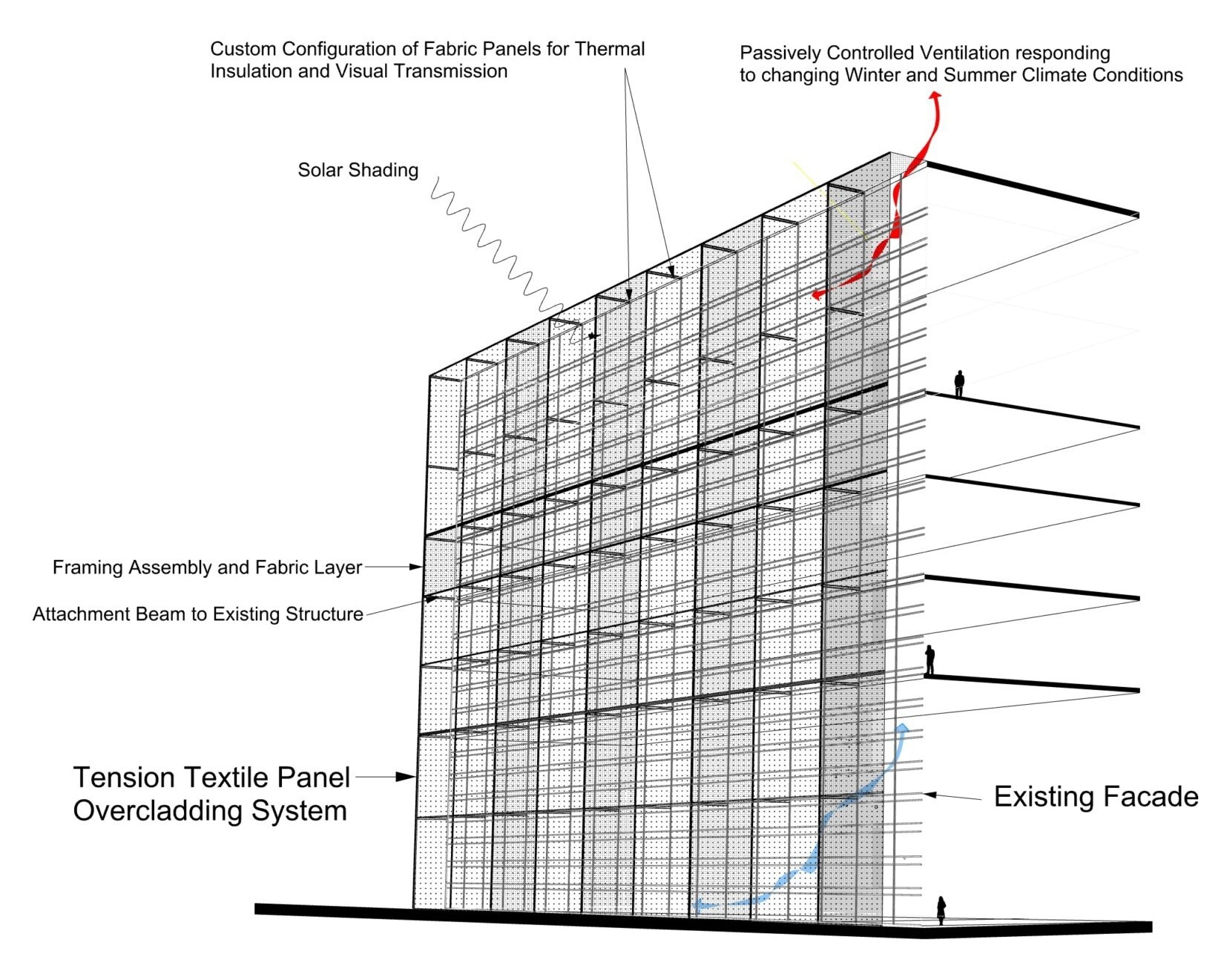Older buildings release heat through their walls, necessitating significantly more energy to maintain a tolerable temperature in the summer or winter. Those built before the late 1970s rarely fulfill today’s more stringent energy standards. Despite this, they account for a sizable part of the buildings still standing today.
 Diagram of tensioned fabric panel overcladding system. Image Credit: Kihong Ku, Thomas Jefferson University.
Diagram of tensioned fabric panel overcladding system. Image Credit: Kihong Ku, Thomas Jefferson University.
In the United States, around 44% of the residential building stock was constructed before 1970, and over half of the commercial buildings that exist today were constructed before the 1980s, indicating a considerable need for energy retrofitting to lessen environmental impact.
A new industry-academic partnership between Jefferson and Lightweight Manufacturing will address this issue in the coming year by inventing textile-based modular “skins” that can inexpensively cover a building’s façade to enhance insulation and energy efficiency.
The concept of using stretched fabrics as spatial cover is an old one. Teepees and yurts are historical examples of utilizing the tensile strength of fabrics for their lightweight protective properties. We are trying to take advantage of the scientific and engineering developments in functional textiles to bring more sustainable solutions to an urgent architectural problem.
Dr. Kihong Ku, Associate Professor, Architecture, Thomas Jefferson University
Dr. Kihong Ku heads the new partnership to create what is called a building overclad.
Overclad approaches present difficulties. Exterior Insulation and Finishing Systems (EIFS) or insulated metal panels, for example, can provide dependable thermal insulation over current masonry or concrete walls. When working with these systems, however, concerns like condensation may necessitate more substantial recladding, which can be costly and disruptive to day-to-day building use and operations.
Dr. Ku’s team intends to collaborate with Lightweight Manufacturing to create fabric-based overclad panels that can be applied to the exterior of a building. The method would assist in enhancing the thermal insulation of the building while maintaining light transmission and airflow.
We are looking at functional textiles with all of these properties so that the building envelope can be sealed. However, because we plan to create modular panels, it’s also possible to have portions that leave windows uncovered, or covered with transparent foil material such as ETFE, a sort of translucent plastic sheeting used as an exterior wall.
Dr. Kihong Ku, Associate Professor, Architecture, Thomas Jefferson University
The panels, intended for mid- and high-rise buildings, would be supported by existing structures and fixed with minimally invasive methods to prevent affecting the existing waterproofing layer.
Dr. Brian George, Director of Engineering Programs at Jefferson, will contribute textile engineering knowledge to the project. An architecture graduate student and two undergraduate students will work on system research and development as well as market analysis.
The venture managed to win funding through a $69,000 Pennsylvania Department of Economic Development grant, which focuses on connecting the PA industry and manufacturing with local universities for their research expertise and brain trust.
We are excited to be able to support this research project with Thomas Jefferson University, which aims to utilize tensioned fabric facade systems to make existing buildings more energy efficient and extend their useful life.
Dirk Cos, President, Lightweight Manufacturing
The group intends to have the prototype fabric and frame system ready to test for wind and weather resistance, and also energy performance, by the end of the year. The team will collaborate with fabric manufacturers to select materials that can endure high amounts of sun, wind, rain, and general weathering to last 20 years or more. “We may need to get creative to create something that can last as long as roof shingles,” notes Dr George.